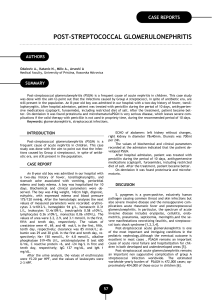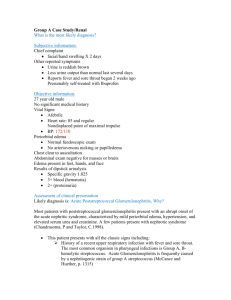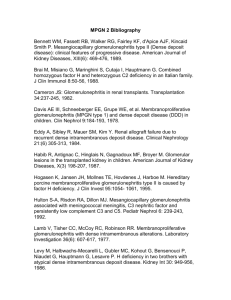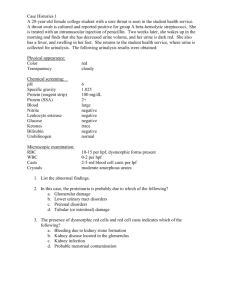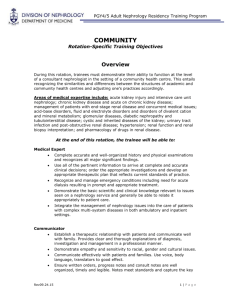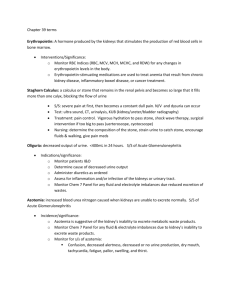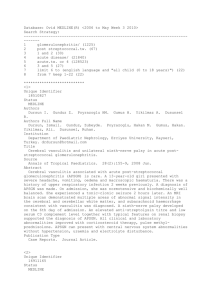ACUTE POST-STREPTOCOCCAL GLOMERULONEPHRITIS
advertisement
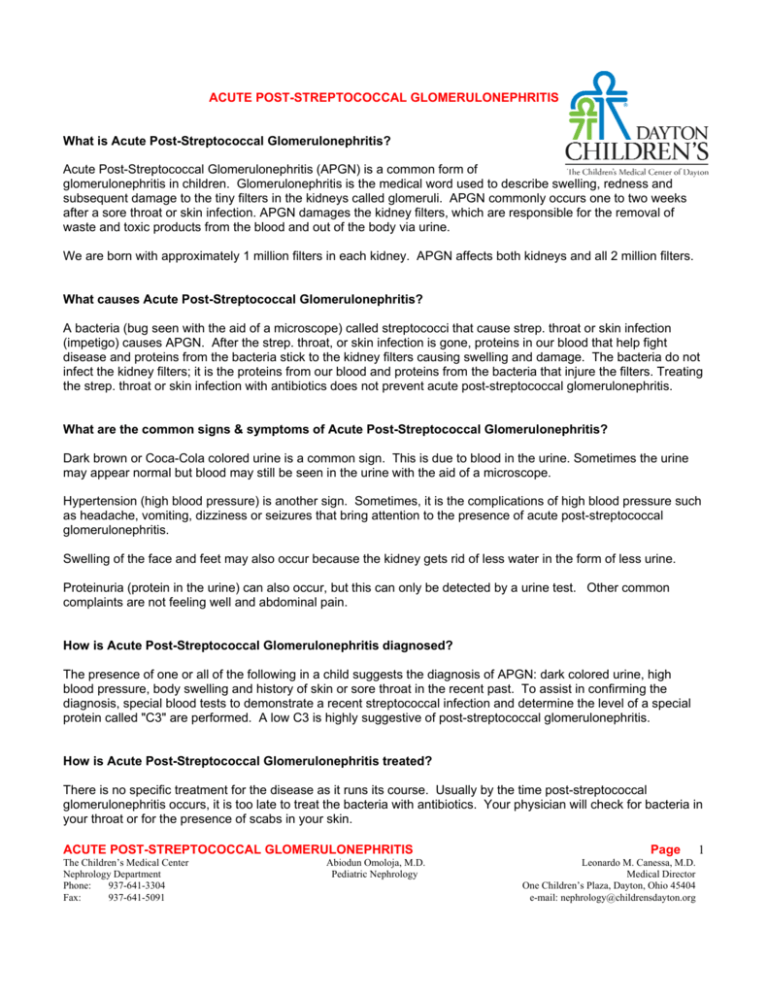
ACUTE POST-STREPTOCOCCAL GLOMERULONEPHRITIS What is Acute Post-Streptococcal Glomerulonephritis? Acute Post-Streptococcal Glomerulonephritis (APGN) is a common form of glomerulonephritis in children. Glomerulonephritis is the medical word used to describe swelling, redness and subsequent damage to the tiny filters in the kidneys called glomeruli. APGN commonly occurs one to two weeks after a sore throat or skin infection. APGN damages the kidney filters, which are responsible for the removal of waste and toxic products from the blood and out of the body via urine. We are born with approximately 1 million filters in each kidney. APGN affects both kidneys and all 2 million filters. What causes Acute Post-Streptococcal Glomerulonephritis? A bacteria (bug seen with the aid of a microscope) called streptococci that cause strep. throat or skin infection (impetigo) causes APGN. After the strep. throat, or skin infection is gone, proteins in our blood that help fight disease and proteins from the bacteria stick to the kidney filters causing swelling and damage. The bacteria do not infect the kidney filters; it is the proteins from our blood and proteins from the bacteria that injure the filters. Treating the strep. throat or skin infection with antibiotics does not prevent acute post-streptococcal glomerulonephritis. What are the common signs & symptoms of Acute Post-Streptococcal Glomerulonephritis? Dark brown or Coca-Cola colored urine is a common sign. This is due to blood in the urine. Sometimes the urine may appear normal but blood may still be seen in the urine with the aid of a microscope. Hypertension (high blood pressure) is another sign. Sometimes, it is the complications of high blood pressure such as headache, vomiting, dizziness or seizures that bring attention to the presence of acute post-streptococcal glomerulonephritis. Swelling of the face and feet may also occur because the kidney gets rid of less water in the form of less urine. Proteinuria (protein in the urine) can also occur, but this can only be detected by a urine test. Other common complaints are not feeling well and abdominal pain. How is Acute Post-Streptococcal Glomerulonephritis diagnosed? The presence of one or all of the following in a child suggests the diagnosis of APGN: dark colored urine, high blood pressure, body swelling and history of skin or sore throat in the recent past. To assist in confirming the diagnosis, special blood tests to demonstrate a recent streptococcal infection and determine the level of a special protein called "C3" are performed. A low C3 is highly suggestive of post-streptococcal glomerulonephritis. How is Acute Post-Streptococcal Glomerulonephritis treated? There is no specific treatment for the disease as it runs its course. Usually by the time post-streptococcal glomerulonephritis occurs, it is too late to treat the bacteria with antibiotics. Your physician will check for bacteria in your throat or for the presence of scabs in your skin. ACUTE POST-STREPTOCOCCAL GLOMERULONEPHRITIS The Children’s Medical Center Nephrology Department Phone: 937-641-3304 Fax: 937-641-5091 Abiodun Omoloja, M.D. Pediatric Nephrology Page Leonardo M. Canessa, M.D. Medical Director One Children’s Plaza, Dayton, Ohio 45404 e-mail: nephrology@childrensdayton.org 1 ACUTE POST-STREPTOCOCCAL GLOMERULONEPHRITIS High blood pressure and body swelling may be treated with medications such as diuretics (water pills) or other medications used to lower blood pressure. Other things that help to control blood pressure include avoiding foods that contain high amounts of salt such as pizza and garlic bread. Your physician may prescribe a low salt diet. Medications that suppress the immune system such as steroids may be used to treat your child depending on the severity of the disease based on blood tests or a kidney biopsy. Will my child need dialysis or a kidney transplant? Based on long-term experience, this is unlikely, as less than 2% of children with the disease need dialysis or kidney transplant. Several factors help your doctors determine the likelihood of this happening. These include duration and severity of damage to the filters as seen on biopsy and blood test results. Very rarely, a tiny piece of kidney tissue has to be obtained and examined using a microscope to confirm the diagnosis. The process of obtaining a piece of kidney tissue is called a biopsy. Your doctor will discuss the specifics of a kidney biopsy with you if needed. What is the long-term outlook for people with Acute Post-Streptococcal Glomerulonephritis? Generally speaking, the long-term outlook is good. The high blood pressure, protein and blood in the urine eventually go away and the C3 eventually returns to normal in about 2 months time (your doctor will request this test be done at or around 4 to 8 weeks after the initial diagnosis). Your child can be expected to make a full and complete recovery with no permanent long-term damage to the kidneys within three to 12 months. Your child can lead a normal lifestyle. Follow-up with your primary care doctor after discharge from the kidney clinic is all that is needed. Very rarely, a child might have Post-Streptococcal Glomerulonephritis more than once. Can my other children or I get Acute Post-Streptococcal Glomerulonephritis? Although "strep. throat" is infectious and can be passed between people who are in close contact, poststreptococcal glomerulonephritis is not infectious. You can seek more information from our Family resource canter on the 2nd Floor of the Taggart Pavilion or from the following websites: http://www.nlm.nih.gov/medlineplus http://www.niddk.nih.gov/ AO-8/02 ACUTE POST-STREPTOCOCCAL GLOMERULONEPHRITIS The Children’s Medical Center Nephrology Department Phone: 937-641-3304 Fax: 937-641-5091 Abiodun Omoloja, M.D. Pediatric Nephrology Page Leonardo M. Canessa, M.D. Medical Director One Children’s Plaza, Dayton, Ohio 45404 e-mail: nephrology@childrensdayton.org 2
